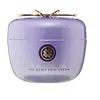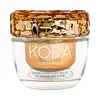What's inside
What's inside
 Key Ingredients
Key Ingredients

 Benefits
Benefits

 Concerns
Concerns

 Ingredients Side-by-side
Ingredients Side-by-side

Water
Skin ConditioningSaccharomyces/Rice Ferment Filtrate
Skin ConditioningGlycerin
HumectantPropanediol
SolventDimethicone
EmollientSqualane
EmollientDiisostearyl Malate
EmollientBehenyl Alcohol
EmollientMyristyl Myristate
EmollientDipentaerythrityl Hexahydroxystearate
EmulsifyingBis-Diglyceryl Polyacyladipate-2
EmollientTridecyl Trimellitate
EmollientInositol
HumectantSorbitan Tristearate
EmulsifyingBeheneth-20
EmulsifyingCamellia Sinensis Leaf Extract
AntimicrobialCladosiphon Okamuranus Extract
Skin ConditioningChondrus Crispus Extract
Skin ConditioningBetaphycus Gelatinum Extract
BleachingOryza Sativa Bran Extract
Skin ConditioningPanax Ginseng Root Extract
EmollientOriganum Majorana Leaf Extract
AntiseborrhoeicThymus Serpyllum Extract
Skin ConditioningMalva Sylvestris Flower Extract
Skin ConditioningSodium Hyaluronate
HumectantGold
Cosmetic ColorantSericin
Skin ConditioningPhytosteryl Macadamiate
Skin ConditioningTocopherol
AntioxidantHydroxyethyl Acrylate/Sodium Acryloyldimethyl Taurate Copolymer
Emulsion StabilisingSorbitan Isostearate
EmulsifyingPolysorbate 60
EmulsifyingButylene Glycol
HumectantDimethicone/Vinyl Dimethicone Crosspolymer
Skin ConditioningSodium Benzoate
MaskingGluconolactone
Skin ConditioningEthylhexylglycerin
Skin ConditioningParfum
MaskingAlcohol
AntimicrobialPhenoxyethanol
PreservativeCitral
PerfumingLimonene
PerfumingLinalool
PerfumingMica
Cosmetic ColorantTin Oxide
AbrasiveCI 77891
Cosmetic ColorantCI 60725
Cosmetic ColorantWater, Saccharomyces/Rice Ferment Filtrate, Glycerin, Propanediol, Dimethicone, Squalane, Diisostearyl Malate, Behenyl Alcohol, Myristyl Myristate, Dipentaerythrityl Hexahydroxystearate, Bis-Diglyceryl Polyacyladipate-2, Tridecyl Trimellitate, Inositol, Sorbitan Tristearate, Beheneth-20, Camellia Sinensis Leaf Extract, Cladosiphon Okamuranus Extract, Chondrus Crispus Extract, Betaphycus Gelatinum Extract, Oryza Sativa Bran Extract, Panax Ginseng Root Extract, Origanum Majorana Leaf Extract, Thymus Serpyllum Extract, Malva Sylvestris Flower Extract, Sodium Hyaluronate, Gold, Sericin, Phytosteryl Macadamiate, Tocopherol, Hydroxyethyl Acrylate/Sodium Acryloyldimethyl Taurate Copolymer, Sorbitan Isostearate, Polysorbate 60, Butylene Glycol, Dimethicone/Vinyl Dimethicone Crosspolymer, Sodium Benzoate, Gluconolactone, Ethylhexylglycerin, Parfum, Alcohol, Phenoxyethanol, Citral, Limonene, Linalool, Mica, Tin Oxide, CI 77891, CI 60725
Aloe Barbadensis Leaf Juice
Skin ConditioningGlycerin
HumectantCoconut Alkanes
EmollientCetearyl Alcohol
EmollientPersea Gratissima Oil
Skin ConditioningRosa Canina Seed Oil
EmollientBalanites Roxburghii Seed Oil
Skin ConditioningWater
Skin ConditioningLactobacillus Ferment
Skin ConditioningCetearyl Olivate
Helianthus Annuus Seed Oil
EmollientSorbitan Olivate
EmulsifyingButyrospermum Parkii Butter
Skin ConditioningHippophae Rhamnoides Fruit Oil
Skin ProtectingPassiflora Edulis Seed Oil
EmollientCaprylic/Capric Triglyceride
MaskingOryza Sativa Extract
AbsorbentLactobacillus
Skin ConditioningAscorbyl Glucoside
AntioxidantCoco-Caprylate/Caprate
EmollientLactobacillus/Arundinaria Gigantea Leaf Ferment Filtrate
Skin ConditioningAstrocaryum Murumuru Seed Butter
EmollientGossypium Herbaceum Seed Oil
Skin ConditioningSaccharomyces Lysate Extract
HumectantBidens Pilosa Extract
HumectantCalendula Officinalis Flower Extract
MaskingCocos Nucifera Fruit Extract
EmollientPotassium Sorbate
PreservativeLavandula Angustifolia Oil
MaskingLinum Usitatissimum Seed Oil
PerfumingLactic Acid
BufferingPhospholipids
Skin ConditioningCitrus Limon Peel Oil
MaskingHydrolyzed Sodium Hyaluronate
Skin ConditioningMentha Piperita Oil
MaskingSclerotium Gum
Emulsion StabilisingPotassium Hydroxide
BufferingCurcuma Longa Root Extract
MaskingGlycyrrhiza Glabra Root Extract
BleachingMorinda Citrifolia Fruit Extract
Skin ConditioningYogurt Powder
Sodium Phytate
Cylindrotheca Fusiformis Extract
AntioxidantLeuconostoc/Radish Root Ferment Filtrate
AntimicrobialCananga Odorata Flower Oil
MaskingJuniperus Virginiana Oil
MaskingLeuconostoc Ferment Filtrate
AntimicrobialTocopherol
AntioxidantBisabolol
MaskingSoybean Peroxidase
AntioxidantSuperoxide Dismutase
AntioxidantAlcohol
AntimicrobialCitral
PerfumingGeraniol
PerfumingLimonene
PerfumingLinalool
PerfumingAloe Barbadensis Leaf Juice, Glycerin, Coconut Alkanes, Cetearyl Alcohol, Persea Gratissima Oil, Rosa Canina Seed Oil, Balanites Roxburghii Seed Oil, Water, Lactobacillus Ferment, Cetearyl Olivate, Helianthus Annuus Seed Oil, Sorbitan Olivate, Butyrospermum Parkii Butter, Hippophae Rhamnoides Fruit Oil, Passiflora Edulis Seed Oil, Caprylic/Capric Triglyceride, Oryza Sativa Extract, Lactobacillus, Ascorbyl Glucoside, Coco-Caprylate/Caprate, Lactobacillus/Arundinaria Gigantea Leaf Ferment Filtrate, Astrocaryum Murumuru Seed Butter, Gossypium Herbaceum Seed Oil, Saccharomyces Lysate Extract, Bidens Pilosa Extract, Calendula Officinalis Flower Extract, Cocos Nucifera Fruit Extract, Potassium Sorbate, Lavandula Angustifolia Oil, Linum Usitatissimum Seed Oil, Lactic Acid, Phospholipids, Citrus Limon Peel Oil, Hydrolyzed Sodium Hyaluronate, Mentha Piperita Oil, Sclerotium Gum, Potassium Hydroxide, Curcuma Longa Root Extract, Glycyrrhiza Glabra Root Extract, Morinda Citrifolia Fruit Extract, Yogurt Powder, Sodium Phytate, Cylindrotheca Fusiformis Extract, Leuconostoc/Radish Root Ferment Filtrate, Cananga Odorata Flower Oil, Juniperus Virginiana Oil, Leuconostoc Ferment Filtrate, Tocopherol, Bisabolol, Soybean Peroxidase, Superoxide Dismutase, Alcohol, Citral, Geraniol, Limonene, Linalool
 Reviews
Reviews

Ingredients Explained
These ingredients are found in both products.
Ingredients higher up in an ingredient list are typically present in a larger amount.
Alcohol comes in many different forms. Different types of alcohol will have different effects on skin. This ingredient is usually an astringent alcohol.
These alcohols are drying on the skin. They may strip away your skin's natural oils and even damage your skin barrier. Astringent alcohols may also irritate skin.
Other types of astringent alcohols include:
According to the National Rosacea Society based in the US, you should be mindful of products with these alcohols in the top half of ingredients.
Any type of sanitizing product will have high amounts of alcohol to help kill bacteria and viruses.
Fatty alcohols come from plant oils such as coconut oil. These can help hydrate the skin and are non-irritating. Some fatty alcohols include cetyl and stearyl alcohol.
Learn more about AlcoholCitral is a fragrance and used to add a lemon-like scent to products. It is both naturally found in plants and created synthetically. In plants, it is commonly occurring in lemon myrtle, lemongrass, lemon tea-tree, lemon verbena, and other citruses.
The EU mandates Citral be listed separately as a fragrance. It is a known allergen and may cause contact dermatitis. Citral can also used as a masking ingredient.
The term 'fragrance' is not regulated in many countries. In many cases, it is up to the brand to define this term. For instance, many brands choose to label themselves as "fragrance-free" because they are not using synthetic fragrances. However, their products may still contain ingredients such as essential oils that are considered a fragrance.
The term 'citral' is a collective term for two geometric isomers: geranial/Citral A and neral/Citral B.
Learn more about CitralGlycerin is already naturally found in your skin. It helps moisturize and protect your skin.
A study from 2016 found glycerin to be more effective as a humectant than AHAs and hyaluronic acid.
As a humectant, it helps the skin stay hydrated by pulling moisture to your skin. The low molecular weight of glycerin allows it to pull moisture into the deeper layers of your skin.
Hydrated skin improves your skin barrier; Your skin barrier helps protect against irritants and bacteria.
Glycerin has also been found to have antimicrobial and antiviral properties. Due to these properties, glycerin is often used in wound and burn treatments.
In cosmetics, glycerin is usually derived from plants such as soybean or palm. However, it can also be sourced from animals, such as tallow or animal fat.
This ingredient is organic, colorless, odorless, and non-toxic.
Glycerin is the name for this ingredient in American English. British English uses Glycerol/Glycerine.
Learn more about GlycerinLimonene is a fragrance that adds scent and taste to a formulation.
It's found in the peel oil of citrus fruits and other plants such as lavender and eucalyptus. The scent of limonene is generally described as "sweet citrus".
Limonene acts as an antioxidant, meaning it helps neutralize free radicals.
When exposed to air, oxidized limonene may sensitize the skin. Because of this, limonene is often avoided by people with sensitive skin.
The term 'fragrance' is not regulated in many countries. In many cases, it is up to the brand to define this term. For instance, many brands choose to label themselves as "fragrance-free" because they are not using synthetic fragrances. However, their products may still contain ingredients such as essential oils that are considered a fragrance.
Learn more about LimoneneLinalool is a fragrance and helps add scent to products. It's derived from common plants such as cinnamon, mint, citrus, and lavender.
Like Limonene, this ingredient oxidizes when exposed to air. Oxidized linalool can cause allergies and skin sensitivity.
This ingredient has a scent that is floral, spicy tropical, and citrus-like.
Learn more about LinaloolTocopherol (also known as Vitamin E) is a common antioxidant used to help protect the skin from free-radicals and strengthen the skin barrier. It's also fat soluble - this means our skin is great at absorbing it.
Vitamin E also helps keep your natural skin lipids healthy. Your lipid skin barrier naturally consists of lipids, ceramides, and fatty acids. Vitamin E offers extra protection for your skin’s lipid barrier, keeping your skin healthy and nourished.
Another benefit is a bit of UV protection. Vitamin E helps reduce the damage caused by UVB rays. (It should not replace your sunscreen). Combining it with Vitamin C can decrease sunburned cells and hyperpigmentation after UV exposure.
You might have noticed Vitamin E + C often paired together. This is because it is great at stabilizing Vitamin C. Using the two together helps increase the effectiveness of both ingredients.
There are often claims that Vitamin E can reduce/prevent scarring, but these claims haven't been confirmed by scientific research.
Learn more about TocopherolWater. It's the most common cosmetic ingredient of all. You'll usually see it at the top of ingredient lists, meaning that it makes up the largest part of the product.
So why is it so popular? Water most often acts as a solvent - this means that it helps dissolve other ingredients into the formulation.
You'll also recognize water as that liquid we all need to stay alive. If you see this, drink a glass of water. Stay hydrated!
Learn more about Water